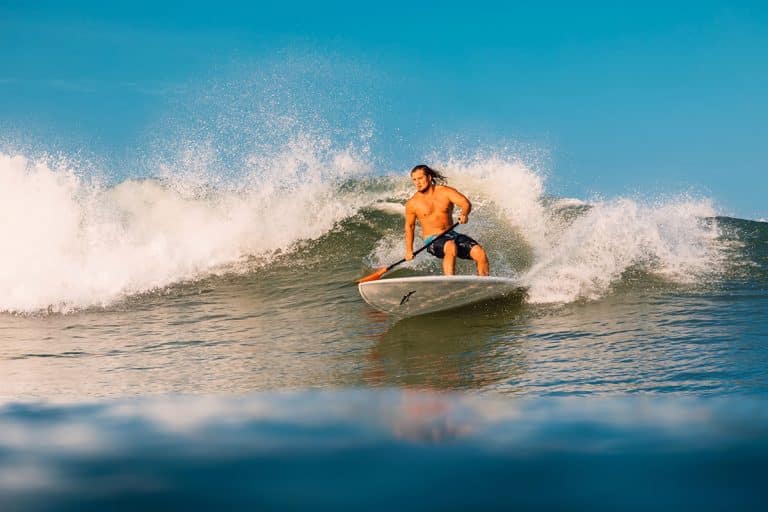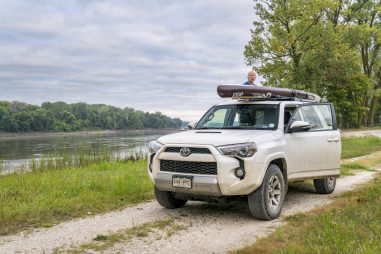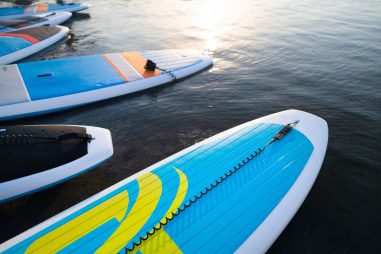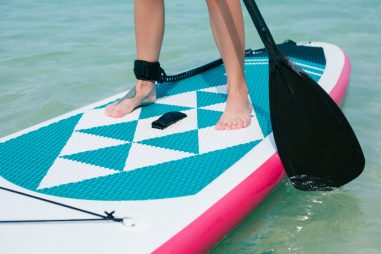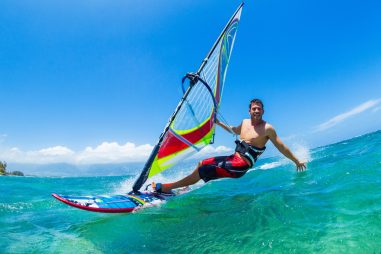These two water-based sports use a board to ride waves or get on top of the water. The board material, length, width, and thickness are the most obvious variation for SUP and surfing. The board curvature or rocker are also modified to fit the person’s riding style. Whether it’s surfing or paddle boarding, a person’s good sense of balance and decent physical fitness is always an advantage.
Is Paddle Boarding Like Surfing?
Standing up on a paddle board has some similarities when going surfing. Although you will most likely do SUP on calm and flat water, learning its fundamentals can significantly help when you transition to surfing. You would need a good sense of balance in both of these water sports to get the most excitement these sports offer.
Maneuvering a surf board and a paddle board is very identical as you would need to utilize the board’s tail and shift your weight to turn. Fins are also used on both surf and SUP boards to aid in maintaining board stability. With the help of the paddle and a larger board, balancing in SUP is easier to master than in surfing. For this reason, people of all ages and gender are attracted to try paddle boarding and do different activities on a SUP board.
Does Paddle Boarding Help With Surfing?
Learning or practicing SUP will significantly assist in your transition to surfing. Since paddle board is also a board water sport, the skills and technique used in SUP do not greatly differ from surfing. Stand up on your board, riding a wave, balancing, and maneuvering are some of the skills that are both vital for surfing and stand up paddling.
Since surfing is a much more extreme and physically demanding sport, a beginner should try SUP first before transitioning to surfing. Being familiar with the board behavior and wave movements in SUP can help before doing surfing. As stand up paddling is often performed in much stable and flat water, it will be best to try rough waters as you slowly become more confident before shifting to surfing.
Is Paddle Boarding Easier or Harder Than Surfing?
People of all ages and different levels of physical fitness can easily learn and enjoy paddle boarding. Since a paddle board is longer and wider than surf boards, standing up on a SUP can only take about 10 minutes for a beginner. Aside from the board being much bigger in stand up paddling, using a paddle also gives you and your board extra stability. Improving your balance and being comfortable in the water is the key to learning any water-based board sports.
Although surfing is much difficult to learn, paddle boarding skills can be a huge help before you transition to surfing. Surfing is also more life-threatening because it is mostly performed on the deeper part of the ocean. It is undoubtedly more physically demanding to do surfing, and a person should be more athletic to enjoy the sport.
What Is the Difference Between a Paddle Board and a Surfboard?
Though both boards look somewhat identical, there are lots of key differences between a paddle board and a surfboard, these differences are vitally important for each board as these sports are performed in their own unique style. Necessary adjustments are carefully made to gain the most competitive edge for a surfer or a paddler. Below are the key variations of a surfboard and paddle board.
- Length: It is evident that a paddle board is longer than a surfing board. A longer board can provide more tracking while sacrificing some turning and steering capabilities. Since SUP activities usually favor tracking, the use of a longer board is much preferred. At the same time, shorter boards are best for surfing because they provide more maneuverability.
- Width: Since SUP is often mixed with other activities like fitness, yoga, and fishing, it makes the use of a wider board more advantageous. You will have more room for your fishing gear, yoga equipment, snacks, and even children on a wide board. The wider board is harder to turn, but it can offer better board stability.
- Thickness: Stand up paddling requires more buoyancy to lift the paddler out of the water. The additional thickness gives more volume to the SUP board resulting in higher buoyancy. In contrast, surf boards are usually one inch less thick than a SUP boards to gain more control on the board.
- Construction material: One of the most famous materials only used for SUP board is inflatable PVC. Inflatable SUP (iSUP) is one the best-selling type of paddle board. For hard paddle boards, fiberglass is most normally used. For surfboards, fiberglass or epoxy is the most common go-to board material for pros.
- Rocker: Surf boards generally have a greater curve than SUP boards. Catching wave is crucial for surfing, and the board should allow the surfer to ride in and out of the wave. The rocker on the surf board makes it possible for the surfer to carve through the wave and avoid nosediving.
| SUP Board | Surf Board | |
| Length | 10 – 11 feet | 7 – 8 feet |
| Width | 32 – 34 inches | 20 – 24 inches |
| Thickness | 4 inches | 2.5 – 3 inches |
| Material | Inflatable PVC, Fiberglass | Fiberglass, Epoxy, EPS |
| Rocker | Mostly Flat | More Curve |
Can I Use My Surfboard as a Paddle Board?
It is possible to use a surf board for SUP, but it is not advisable and can be very difficult. The experience will be less comfortable and more challenging than using a paddle board. Surfboards have low buoyancy so expect that your board will catch water more often. A shorter surfboard for paddling boarding can also be hard to balance and will produce less tracking.
You would need to have a good sense of balance to use a surfboard for paddling. It is preferable to use a long surf board for paddle boarding to provide more buoyancy and tracking that will be more fitted for the usual SUP activities. A larger and wider surfboard can also help in increasing the board volume to attain greater buoyancy. Ultimately, it all boils down to the rider’s body weight and skill to balance to make the surfboard work for paddle boarding.
Can You Use a Surfer Longboard as a Paddle Board?
Using a longboard is much closer to paddle board than short surf boards because of its added length, thickness, and width. This results in added buoyancy that makes it more bearable to us for SUP. But even with its added volume, it is still often not adequate as an ideal substitute for paddle boarding.
Bodyweight significantly influences the board behavior when paddle boarding. For heavier paddlers using a long surf board may not be sufficient to support their weight for paddling. Be sure that the surf board has adequate volume to avoid sinking when standing up on the board when paddling.
Can a Paddle Board Be Used for Surfing?
The best way to safely surf with a SUP board is by using an inflatable paddle board. iSUP is known for its rigidity and is stiff enough to ride waves. It also turns well and has better maneuverability than hard paddle boards, which plays an important factor when riding a wave.
Surfing on a big wave can still be a little difficult, even when using an inflatable paddle board. The reason for this is simply because SUPs are not specially built to ride on rough waters. It is more manageable to ‘ride down’ a wave when using a paddle board than fully surfing a full-blown wave.
Can You Surf on an Inflatable Paddle Board?
An inflatable paddle board or iSUP is the best option for a paddle board to use for surfing. It is the safest type of SUP to use for surfing for you and other surfers as well. Since it is pumped with air and made out of PVC, you will be less likely to get injured or hurt when it hits you and other beachgoers.
iSUPs are short and wide, which makes it easy to turn and steer, which is a vital part of SUP surfing. Inflatables also have a more pronounced rocker than traditional paddle boards. This added board curvature is a huge help to ride a wave continuously.
What Is the Best Paddle Board for Surfing?
Almost any paddle surfers will recommend getting an inflatable board (iSUP) for paddle boarding. It is the perfect type of paddle board to use for surfing because it provides excellent rigidity. Even though it is stiff and strong, it is the safest type to use and can prevent injuries when you get hit by it since its inside is air rather than a solid material.
Aside from its remarkable surfing qualities, inflatables are very convenient to pack and transport. As for the SUP paddle, you can still use your regular paddle, but it is advisable to reduce its length by around 10 cm. Also, make sure that the SUP paddle is strong enough to handle the ocean waves.

